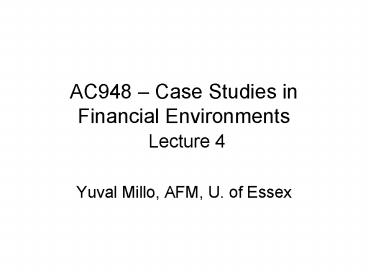AC948 Case Studies in Financial Environments Lecture 4
1 / 10
Title:
AC948 Case Studies in Financial Environments Lecture 4
Description:
In the last lecture we saw how distributed agency in hedge funds (investors and ... In this lecture we will focus on how that market-based risk management ... –
Number of Views:27
Avg rating:3.0/5.0
Title: AC948 Case Studies in Financial Environments Lecture 4
1
AC948 Case Studies in Financial Environments
Lecture 4
- Yuval Millo, AFM, U. of Essex
2
Organisational aspects of arbitrage
- In the last lecture we saw how distributed agency
in hedge funds (investors and traders) affected
arbitrage positions. - In this lecture we will focus on how that
market-based risk management techniques, and
especially Value at Risk (VaR) effected arbitrage
operations in hedge funds such as LTCM.
3
Discovering the value of a trading portfolio
- Traditional method price at the date of
buying or selling - Problem value changed between opening and
closing positions, and liabilities may lead to
losses - Marking to market value is updated using market
prices - Assumption markets are liquid and assets can be
turned to cash at any time
4
Marking-to-model
- What if there is no liquid market for the assets
(such as swaps)? - Value is found using a mathematical model.
- As a result, the actual liquidity of the assets
was less significant as a decision-making factor
than the results that the model produced. - What are the possible risks that may arise as a
result?
5
Expressing risk in simple terms
- As agency in trading firms become more
diversified, and more different expertise was
necessary, decision-making became challenging - How much capital to allocate to each asset?
- How to spread the capital among the traders?
- Managers were looking for a method that would
simplify the positions in the market.
6
Value at Risk 1
- To allocate capital, it is necessary to assess
the possible risk. - For example, what is the maximal amount that a
certain portfolio can lose during a trading day? - 95 of the samples in a normal distribution are
within 1.645 standard deviations from the mean.
7
Value at Risk 2
- The maximal daily loss for 95 of the cases is
calculated by - 1.645 x x
daily volatility of the portfolio
Size of the portfolio
8
RAROC
- Risk adjusted return on capital how much return
per unit of risk. - Like in VaR, it is assumed that returns follow a
normal distribution. - For example annual return / annual volatility
can help to decide which stock is a better
choice.
9
VaR and RAROC as managerial tools
- The tools can be used to choose assets (design
portfolios), but also to decide which trader, and
which trading strategy gives the best return for
the risk taken. - For example, trader who has a low risk-adjusted
return and high VaR would be demanded to keep
higher capital reserves to compensate for losses.
10
VaR as a managerial tools implication
- Using market-based risk management tools can
bring about problems - High market volatility ? breaching of VaR limits?
Higher reserved capital ? imposed selling ? more
market volatility - In addition, as we saw in the 1987 case, such
selling may be misinterpreted and bring about
panic selling.































